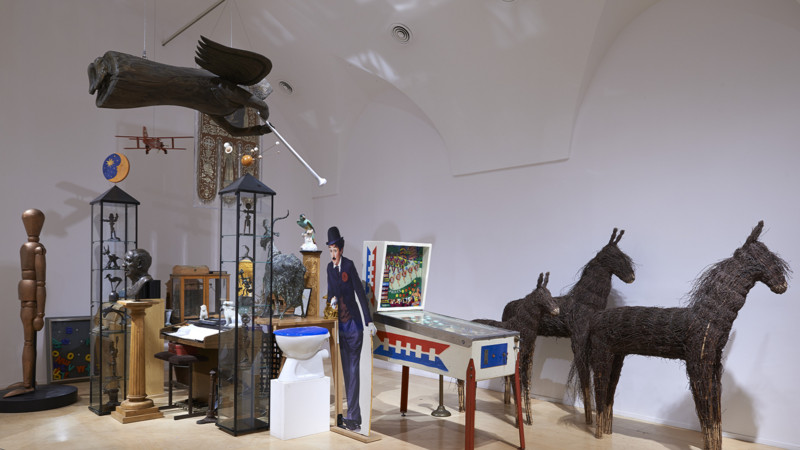The order of time and things
26 Mar - 01 Sep 2014
THE ORDER OF TIME AND THINGS
The home studio of Hanne Darboven
26 March – 1 September 2014
Known for her large-scale works that combine geometric drawings, numerical series, images and writings, Hanne Darboven (Munich, 1941 - Hamburg, 2009) is often associated with conceptual art, a correlation that should be nuanced further given the unmistakeably subjective nature of the process of realisation and expression of her works, which are often peppered with autobiographical references and mentions of the site of production.
This exhibition assembles a broad range of her artworks and a highly diverse mélange of objects (toys, mannequins, musical instruments, promotional items, souvenirs from different corners of the earth...) that Darboven amassed in her family home in Am Burgberg, where she lived and worked her whole life (apart from a brief two-year stint in New York in the mid sixties). More than a studio in use, it is akin to the Cabinets of Curiosities or Wonder Rooms that proliferated in the 16th and 17th centuries.
The exhibit – not conceived as a retrospective exhibition or anthology – presents a journey that recreates the complex and fascinating world of Darboven’s home studio, enabling not only a closer look inside this place and in each of time periods amassed, but also a reconsideration of the numerical writing and serial pieces the artist produced throughout her career, where the temporary, in its deployment, gained volumetric consistency. All of this from the premise that the brimming discourse her studio conveys would seem to contradict the Cartesian sobriety of her plastic expression, yet deep down both logics were closely linked, driven by the same urge – the desperate attempt to reduce the complexity of the world to diagrams, grid structures and narrative devices, or elements of scenography that to the eye make sense of what overwhelms it.
Therefore, Darboven’s home studio forms the starting and arrival point of her work, both materially and conceptually; a key part of her legacy and essential to her oeuvre. A legacy and work that, similar to other artists that at the end of the 20th century critically addressed the invisible inheritance of modernity (whose most patent graphic expression was a classifying grid that, it must be remembered, played a key role in Darboven’s work), are imbued with a latent and unsettling ambiguity, linking civilisation and brutality, rational systemisation and instinctive impulse. For it is exactly in this indeterminacy that the artist appears to search for her place in the world.
The home studio of Hanne Darboven
26 March – 1 September 2014
Known for her large-scale works that combine geometric drawings, numerical series, images and writings, Hanne Darboven (Munich, 1941 - Hamburg, 2009) is often associated with conceptual art, a correlation that should be nuanced further given the unmistakeably subjective nature of the process of realisation and expression of her works, which are often peppered with autobiographical references and mentions of the site of production.
This exhibition assembles a broad range of her artworks and a highly diverse mélange of objects (toys, mannequins, musical instruments, promotional items, souvenirs from different corners of the earth...) that Darboven amassed in her family home in Am Burgberg, where she lived and worked her whole life (apart from a brief two-year stint in New York in the mid sixties). More than a studio in use, it is akin to the Cabinets of Curiosities or Wonder Rooms that proliferated in the 16th and 17th centuries.
The exhibit – not conceived as a retrospective exhibition or anthology – presents a journey that recreates the complex and fascinating world of Darboven’s home studio, enabling not only a closer look inside this place and in each of time periods amassed, but also a reconsideration of the numerical writing and serial pieces the artist produced throughout her career, where the temporary, in its deployment, gained volumetric consistency. All of this from the premise that the brimming discourse her studio conveys would seem to contradict the Cartesian sobriety of her plastic expression, yet deep down both logics were closely linked, driven by the same urge – the desperate attempt to reduce the complexity of the world to diagrams, grid structures and narrative devices, or elements of scenography that to the eye make sense of what overwhelms it.
Therefore, Darboven’s home studio forms the starting and arrival point of her work, both materially and conceptually; a key part of her legacy and essential to her oeuvre. A legacy and work that, similar to other artists that at the end of the 20th century critically addressed the invisible inheritance of modernity (whose most patent graphic expression was a classifying grid that, it must be remembered, played a key role in Darboven’s work), are imbued with a latent and unsettling ambiguity, linking civilisation and brutality, rational systemisation and instinctive impulse. For it is exactly in this indeterminacy that the artist appears to search for her place in the world.

